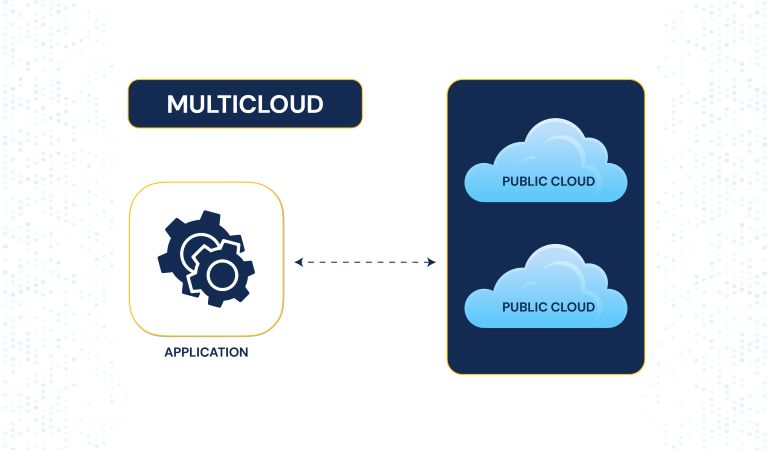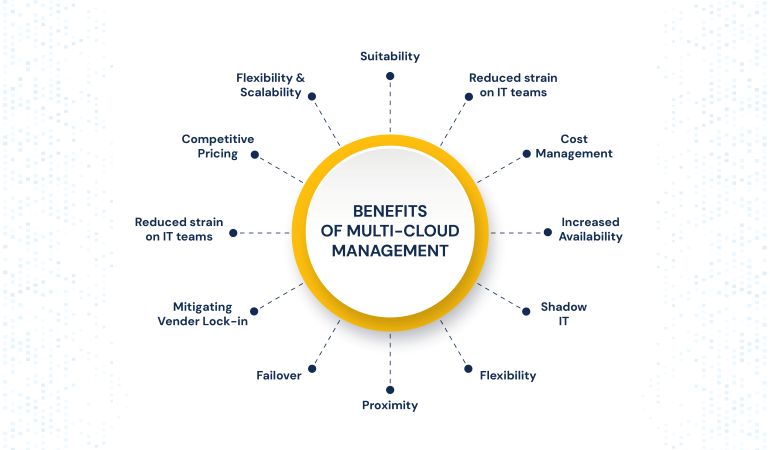Cloud computing is already making waves worldwide, with an increasing number of enterprises leveraging incredible technology to achieve their business goals. Many cloud experts believe that more and more companies will switch to a multicloud strategy in the coming years. So, the question is, what is driving this change?
This article explains the basics of multicloud management, its benefits, challenges, and why companies use it.
What is Multicloud Management?
Multicloud refers to using multiple cloud services provider to manage an application or an ecosystem of applications operating in a typical architecture. You can use it as software-as-a-service (SaaS), platform-as-a-service (PaaS), and infrastructure-as-a-service (IaaS) from various cloud vendors like AWS, IBM Cloud, Microsoft Azure, and Google Cloud services. Most enterprises typically run their applications on PaaS and IaaS.

Multicloud management is a term used to describe a company’s strategy of managing cloud services from various vendors using a centralized environment.
Your multicloud strategy can include the following:
- Several public cloud service providers.
- Hybrid clouds (private cloud plus public cloud).
- On-premises cloud environments.
A multicloud solution is portable – it is developed on cloud-native, open-source technologies like Kubernetes and is supported by several cloud vendors’ cloud infrastructures.
Such multicloud solutions enable you to manage cloud workloads using a central console. Several cloud service providers and cloud solution providers offer these development solutions: compute infrastructure, cloud storage, data warehousing, AI/ML (artificial intelligence and machine learning), and more.
How Does a Multicloud Approach Works?
Multicloud management strategies involve several architectural approaches. You can develop distinct parts of an application stack in different cloud environments. In such an approach, each part of the application stack accesses different services and systems needed to work together. However, developers build logic in the application instead of on the infrastructure side in such cases.
Other scenarios also exist. For example, you may want the same application services to run in various cloud environments with minimal, if any, changes to the application code. This approach once entailed significant challenges. However, open-source technologies like Kubernetes have made it much more convenient today.
Here are some of the primary features of using a multicloud approach:
- Self-service provisioning: you can choose a cloud environment for deploying a specific application or its parts. The vendor does not interfere, and you can make decisions based on your requirements.
- Workflow automation: allows users to automate their tasks by creating and managing computing instances without human involvement.
- Scheduled tasks: users can plan their tasks at predetermined intervals.
- Reporting: it enables users to access multiple reports using a centralized console.
Difference between Multicloud Management and Hybrid Cloud
A hybrid cloud network also combines multiple clouds. However, a hybrid cloud combines a public cloud with private cloud infrastructure or on-premises hardware. This private-public cloud combination gives more control over cloud servers. Companies can use private clouds for high-security needs while relying on public clouds for other business functions.
Benefits of Multicloud Management
The most significant benefit of adopting a multicloud approach is that it helps you avoid ‘vendor lock-in.’ Vendor lock-in is when a company depends on a single cloud service provider for a service or set of services. Moreover, the company can’t switch to another vendor due to legal constraints, high costs of switching, or technical issues.
Relying on just one cloud-based service provider often puts you in a tight spot. It entails performance issues, unnecessary costs, and limited options due to one vendor.
Here are some of the key benefits of multicloud.

-
Security
As cyber threats grow in number and intensity, the security of vital enterprise data is often the most critical concern for many IT and business executives. Moreover, employing a multicloud approach can make your cloud management and security an uphill task, with the probability of cyber threats growing.
Nevertheless, multicloud solutions come armed with various cloud security mechanisms and features like automation and monitoring, thus helping you reduce the probability of a successful cyberattack against your cloud infrastructure. Moreover, these multicloud solutions also support enforcing a consistent security policy across all cloud environments.
-
Aids Regulatory Compliance
Multicloud solutions help you adhere to government regulations like the General Data Protection Regulation (GDPR) and the Health Insurance Portability and Accountability Act (HIPAA). These regulations direct organizations to store customer data in specific locations.
A multicloud strategy enables you to provide data securely and safely without managing your on-premises data centers.
-
Improves Performance
You can use a multicloud strategy to build a robust IT infrastructure that lowers cloud integration costs and optimizes application performance. A multicloud approach allows you to improve user experience (UX) and application responsiveness by letting you create unique connections.
It lets you choose the vendor you want based on location, price, features, and performance offered by a service provider.
-
Enhances Resilience
Application downtime can occur at any time, irrespective of the vendor. Hence, relying on only one cloud service provider is very risky. By adopting a multicloud strategy, companies can spread their downtime and outage risk across multiple vendors. This improves security, reduces vulnerability, increases disaster recovery, and gives better fail-over options.
Multicloud management enables consistent and continuous availability of data storage resources, thus making deployment resilient for cloud-based applications. It also reduces latency and packet loss, improving your application performance.
-
Allows Better Flexibility
A key benefit of adopting a multicloud approach is that it allows you to choose cloud-based services from different vendors. You can choose the best service a given vendor offers while choosing another vendor renowned for another cloud service, helping you build an incredible cloud environment.
Other factors impacting your decision include pricing, location, security, performance, and compliance needs.
Challenges of Multicloud Management
While a multicloud infrastructure has many benefits, significant challenges are also involved.
Let’s look at some significant challenges you will likely face in a multicloud environment.
-
More Complexity
Creating and managing multicloud environments is a tall order due to complexity. You might find it challenging to implement a multicloud solution.
-
Shortage of Skilled IT Experts
The pace at which cloud computing grows is too much for the labor market to manage. As a result, there is a severe shortage of experienced and skilled cloud engineers and experts. Moreover, it isn’t easy to find resources adept at using and managing multicloud environments where companies use services from vendors like AWS, Azure, Google, and IBM.
-
Integrating Different Environments
Another major challenge multicloud users face is integrating different cloud platforms. As each cloud environment differs, companies must ensure their applications are cross-platform, thus avoiding integration issues.
But building cross-platform apps can be difficult. However, you can use containers for easier application portability for different cloud vendors.
-
High Costs
Multicloud environments can be costly if users fail to decommission unused cloud instances. This is called cloud sprawl. Costs for different cloud services often spiral out of control under such conditions.
-
Reconfiguration Issues
In a multi-cloud environment, you deploy your applications to different cloud environments. This may lead to reconfiguration issues as the application adapts to its specific cloud environment. You must also work significantly to move applications between various cloud environments. And sometimes, the apps run differently in each cloud, causing inefficiencies.
Steps for Workload Migration in Multi-Cloud Environments
Effectively migrating workloads across multi-cloud platforms requires careful planning. Follow these steps to ensure purpose-driven migration:
-
Ensure Workload Portability
- Design workloads to be easily portable without requiring significant modifications.
- Utilize containers to package applications and their dependencies for smooth movement between clouds.
-
Maintain Consistent Application Management
- Use a cloud management platform to enforce uniform policies across all cloud environments.
- Simplify workload governance and ensure each application is deployed on the optimal platform.
-
Plan Workload Movements with Clear Objectives
- Move workloads only when necessary, considering the effort and potential performance impacts.
- Establish a clear multicloud strategy.
A Guide For Multicloud Managers
There are different strategies for multicloud management, but the best ones have some standard features. Multicloud managers need to know these features to manage a multicloud environment effectively.
Here are the standard features of the best multicloud management solutions:
- Unified Dashboards
- Automation
- Workload Portability
- Support for DevOps
- Real-Time Monitoring
Conclusion
Companies worldwide are adopting multicloud management despite the challenges it poses. That is because it is possible to manage the difficulties involved in multicloud environments.
The flexibility, resilience, cost efficiency, and improved performance and security offered by multicloud are too good to be ignored. In the future, we will see more and more companies diversifying their cloud setups, looking to unlock the power of cloud computing.
Are you planning to switch from a single cloud service provider to more than one? Xavor is a proud AWS and Azure partner. We offer Google Cloud Platform, AWS, and Microsoft Azure cloud services and solutions tailored to meet your specific needs.
Contact us at [email protected] to book a FREE consultation session with our Cloud & DevOps team.

